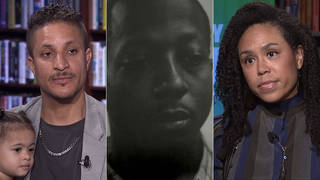
Guests
- Tom Robbinscontributing writer with The Marshall Project and investigative journalist in residence at the Craig Newmark Graduate School of Journalism at CUNY.
A major new Marshall Project investigation looks at the the mental health crisis in U.S. prisons by diving deep into the story of Karl Taylor, a prisoner who died at a maximum-security prison in the Catskills of New York after an altercation with prison guards in 2015. Karl Taylor was serving out a minimum 27-year sentence for a rape conviction when his life came to a sudden end at the Sullivan Correctional Facility in April of 2015. The African-American prisoner had been diagnosed with delusional disorder and paranoid personality disorder when he was taken into custody in 1995. By April of 2015, Taylor was housed in a special unit at Sullivan for prisoners classified as mentally ill. He had spent nearly 10 years in solitary confinement. That’s when he got into what would turn out to be a fatal altercation with a prison guard. We speak with investigative reporter Tom Robbins, author of “Why Is Karl Taylor Dead?”
Transcript
AMY GOODMAN: This is Democracy Now! I’m Amy Goodman, with Juan González.
JUAN GONZÁLEZ: Why is Karl Taylor dead? That’s the question asked by The Marshall Project in a major new investigation, out today, that looks at the mental health crisis in U.S. prisons by diving deep into the story of Karl Taylor, an inmate at a maximum-security prison in the Catskills of New York who died after an altercation with prison guards in 2015. Karl Taylor was serving out a minimum 27-year sentence for a rape conviction when his life came to a sudden end at the Sullivan Correctional Facility in April of 2015. The African-American prisoner had been diagnosed with delusional disorder and paranoid personality disorder when he was taken into custody in 1995. By April of 2015, Taylor was housed in a special unit at Sullivan for prisoners classified as mentally ill. He had spent nearly 10 years in solitary confinement. That’s when he got into what would turn out to be a fatal altercation with a prison guard.
AMY GOODMAN: Investigative reporter Tom Robbins looks not only at Karl Taylor’s death, but also at how people and systems repeatedly failed Taylor over the 20 years he spent in prison. The result is a sweeping look at the state of mental health in the U.S. prisons as the number of prisoners with mental health issues continues to rise despite the overall number of people in prison decreasing. At the time of Karl Taylor’s death, one-fifth of the prison population in New York state’s correctional facilities were diagnosed with mental illness.
For more, Tom Robbins joins us here in our New York studio, the author of “Why Is Karl Taylor Dead?” the investigation from The Marshall Project in partnership with The Atlantic.
Welcome back to Democracy Now!, Tom.
TOM ROBBINS: Good morning, Amy. Good to be here. Good morning, Juan.
AMY GOODMAN: So tell us what happened on April 13th, 2015.
TOM ROBBINS: Karl Taylor was someone who had been in prison for 20 years at that point. And throughout—he had twice been sent to the state’s prison psychiatric hospital to get court-ordered medications to basically calm the demons that haunted him. He was a man who had probably suffered mental illness most of his life. We don’t know whether or not anything was diagnosed before he was arrested and sent to prison—for an awful crime: He was convicted of rape. But we do know that the very month that he was taken into state custody, they said, “This guy is severely mentally ill.” And yet, despite that, he bounced around for 20 years in some of the toughest prisons in New York state, maximum-security prisons like Clinton, like Attica.
And he ends up here at Sullivan in a unit that was supposed to be kind of a safe area for those who had mental problems and other disabilities, but was policed by guards who had very little training and, most of them, not much interest in dealing with folks who have those kinds of problems. And he had been unwilling or unable to clean his cell, which had been searched and trashed in the way guards do it when they go routinely searching through people’s cells. And he said, “I’m not cleaning it up.” And one guard in particular was so outraged by his refusal to do it that he kept insisting, “You’re going to clean it up, or there’s going to be problems.”
And on that morning, an altercation broke out. And there’s two versions of what happened. The guards say that Karl Taylor swung first and decked a guard named Bruce Tucker. Every inmate that’s been interviewed about this case, by myself and by the attorneys who are handling the civil suits that resulted from it, give it a completely opposite version—that the guard named Bruce Tucker struck Karl Taylor so hard that one inmate said it sounded like the crack of a baseball bat. He was dead within a half-hour.
JUAN GONZÁLEZ: And, Tom, this whole issue of the mentally ill in prisons—a lot of people, one, they don’t know the percentage, the great percentage, but also, it’s assumed that this has always been so, but this really wasn’t always so. Wasn’t there a period when our governments, state governments especially, started deinstitutionalizing the mentally ill, closing down mental health facilities, and then the prison population of the mentally ill who were imprisoned then skyrocketed, because they basically were thrown out of these mental hospitals where they were before?
TOM ROBBINS: You know, there’s a debate among the experts as to whether or not you can say that’s the parallel, but there’s no question that’s the way the numbers go. In fact, there are charts that show—just like that—you know, that the number of people declining in the state mental institutions and the number of mentally ill in prisons goes up. A lot of those institutions, as you and I remember, places like Willowbrook, got shut down because they were terrible places to reside in, you know, and there were terrible things being done to folks there. And the idea was that people would be able to get medication and stay in their community. And for some people, it worked out, but for a lot of people, it didn’t. And so, instead of figuring out an interim way to deal with these folks, we just sent them into prison. And we continue to do that.
AMY GOODMAN: And what was Bruce Tucker’s record, the prison guard who apparently, according to his friends, that killed him?
TOM ROBBINS: Well, you know, it’s interesting. You know, I’ve done a lot of these stories at this point, and usually you can find like a long legal trail, and you can find instances where the officer had been cited. Tucker had never been disciplined for anything that had happened, and yet there was a universal opinion amongst those who had dealt with him, including folks who worked in a special mental crisis unit, that Tucker was known for being very rough with prisoners. And one of the unique things about this story is that we have extensive quotes from one of his colleagues, another guard who worked in the same unit, who said basically he didn’t think Tucker was cut out for corrections. And he said that, as he was giving a deposition to the lawyers in the case, “We wouldn’t be sitting here now talking about this, if not for Bruce Tucker.”
JUAN GONZÁLEZ: Tell us how much difficulty you had in actually ferreting out this story.
Because, obviously, prisons are not the kinds of places where you just file a Freedom of Information request and you automatically, within a few days, get a response from the prison authorities to your request. How were you able to ferret out the story?
TOM ROBBINS: Well, you know, I played an unusual role in this piece, Juan. You know, as reporters, we’re usually supposed to take a standoff—you know, like just follow whatever you can find. But Karl Taylor died about three months after I had finished a very long piece about Attica for The Marshall Project in The New York Times. And during the interviews for that piece, I met with the state corrections commissioner who told me, “We have a zero-tolerance policy for abuse by staff.” And then the death of Karl Taylor happened. And within another week, there was another man named Samuel Harrell who was killed in Fishkill at the same time.
And I wanted to know what had happened with Karl Taylor. And I managed to find a couple of people who were still incarcerated, and I found a guy who had just gotten out who had been a witness. But nobody knew who his family were. They said, “Please, if you can find his family, convey our condolences.” Because they felt so terrible. And I couldn’t find them, but eventually I found an online obituary that had run in the Albany Times Union. And I went to the funeral parlor, which is not far from the state Capitol, and just left my card and said, “I would really like to talk to the family if they’d care to talk to me.”
And later that day I got a call from Julia Ramsay-Nobles, who is Karl’s older sister. And she was very skeptical of me, like, “Why does he—?” She said to me when we first sat down, “Why does any Caucasian really care about an African-American life?” And I was like, “Well, I just want to know what happened to your brother.” And I gave her the number of a prison reform advocate I knew and said, “Look, if you want to pursue this beyond—I’m going to chase it, but if you want to pursue this on your own, talk to this person.” And she did. And as a result, this extraordinary effort by this law firm, Patterson Belknap Webb & Tyler, has led to getting documents and records that I never would have been able to get even with the Freedom of Information Act, that helped me do this story.
AMY GOODMAN: Karl Taylor was in solitary confinement for a decade. What effect does that have? Half of the time he was imprisoned.
TOM ROBBINS: You know, every single expert agrees that even short periods of time in solitary confinement disables people, that it makes sane people crazy. It makes crazy people much crazier. And there’s no question—at one point after he had been in solitary confinement for a long period of time, Karl Taylor was observed on all fours barking like a dog. You know, you can just imagine the kind of pain the guy must have been in, to have been performing like that. And yet their solution to that was more punishment. You know, they sent him twice to the state hospital, and it would work for a while, and then he would be right back in the same position.
JUAN GONZÁLEZ: What about the mental health services? Given the declining prison population, certainly in New York state and other states, you would think that the state would have a little extra money to be able to devote to better mental health treatment for those who are incarcerated.
TOM ROBBINS: Well, the state has extensive programs for dealing with mentally ill prisoners, and they will tell you that they have many of these satellite units, including the one that Karl Taylor was in at Sullivan Correctional Facility. And there are lots of caring doctors and nurses and psychologists who are there. I think the problem essentially is they’re still in a correctional environment, which are like—these are like being in the Army. It’s military rules, you know?
I mean, I had a great quote from Brian Fischer, who’s the former commissioner of corrections for New York state, who said, “What do we do with an inmate who is getting an order from a guard at the same time he’s getting an order from the voice in his head? Which voice is he going to listen to?” Karl Taylor clearly listened to the voice in his head, and a tragedy resulted.
AMY GOODMAN: “Why Is Karl Taylor Dead?” That is the name, the title, of the piece, subtitled “Our prisons are our mental wards.” Tom Robbins, contributing writer with The Marshall Project, investigative journalist in residence at the Graduate School of Journalism at CUNY.
JUAN GONZÁLEZ: And congrats on your award from City Limits recently for your investigative journalism.
TOM ROBBINS: Thank you, Juan.
AMY GOODMAN: If you can stay, we want to just continue to ask you about the kind of changes that are being talked about in the New York state and countrywide in prisons. I’m Amy Goodman, with Juan González. Thanks for joining us.












Media Options